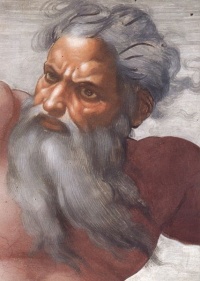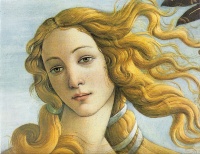Anthropotheism
From The Art and Popular Culture Encyclopedia
| Revision as of 11:05, 13 July 2013 Jahsonic (Talk | contribs) ← Previous diff |
Current revision Jahsonic (Talk | contribs) |
||
| Line 1: | Line 1: | ||
| + | {| class="toccolours" style="float: left; margin-left: 1em; margin-right: 2em; font-size: 85%; background:#c6dbf7; color:black; width:30em; max-width: 40%;" cellspacing="5" | ||
| + | | style="text-align: left;" | | ||
| + | "But if cattle and horses and lions had hands [[But if cattle and horses and lions had hands|[...]]]" --Xenophanes | ||
| + | |} | ||
| + | [[Image:God.jpg|thumb|right|200px|Detail of [[Sistine Chapel]] fresco ''[[Creation of the Sun and Moon]]'' by [[Michelangelo]] (completed [[1512]]).]][[Image:Birth Venus Botticelli.jpg|right|thumb|200px|''[[The Birth of Venus (Botticelli)|The Birth of Venus]]'' (detail), a [[1486]] painting by [[Sandro Botticelli]]]] | ||
| {{Template}} | {{Template}} | ||
| - | '''Anthropotheism''' is ascribing human form and nature to gods, or the belief that gods are only [[deified]] human beings. Associated with classical [[Greek mythology|Greek]] and [[Roman mythology|Roman]] beliefs, a type of anthropotheism finds a modern expression in the [[Mormon]] world-view of eternal progression. Vestiges of Hebrew anthropotheism can be discerned throughout the [[Hebrew Bible]]. It is a type of [[physitheism]]. | + | '''Anthropotheism''' is ascribing [[human form]] and [[human nature|nature]] to gods, or the belief that gods are only [[deified]] human beings. Associated with classical [[Greek mythology|Greek]] and [[Roman mythology|Roman]] beliefs, a type of anthropotheism finds a modern expression in the [[Mormon]] world-view of eternal progression. Vestiges of Hebrew anthropotheism can be discerned throughout the [[Hebrew Bible]]. It is a type of [[physitheism]]. |
| The attribution of human general qualities to divine beings may be called [[anthropopathy]]. | The attribution of human general qualities to divine beings may be called [[anthropopathy]]. | ||
| + | ==Criticism== | ||
| + | [[Xenophanes]] is quoted in [[Clement of Alexandria]], arguing against the conception of gods as fundamentally [[anthropomorphic]]: | ||
| + | <blockquote>But if cattle and horses and lions had hands<br>or could paint with their hands and create works such as men do,<br>horses like horses and cattle like cattle<br>also would depict the gods' shapes and make their bodies<br>of such a sort as the form they themselves have.<br>...<br>[[Ethiopians]] say that their gods are snub–nosed [σιμούς] and black<br>[[Thracians]] that they are pale and red-haired. | ||
| + | </blockquote> | ||
| - | [[Xenophanes]] | ||
| - | ==Criticism== | ||
| Early Christian writers such as [[Melito]], [[Tertullian]], [[Origen]] and [[Lactantius]] were accused of anthropomorphism. | Early Christian writers such as [[Melito]], [[Tertullian]], [[Origen]] and [[Lactantius]] were accused of anthropomorphism. | ||
| Line 11: | Line 18: | ||
| In modern times, [[Benny Hinn]] has also taught a form of anthropomorphism. | In modern times, [[Benny Hinn]] has also taught a form of anthropomorphism. | ||
| - | |||
| ==See also== | ==See also== | ||
| + | *[[Theomorphism]] | ||
| + | *[[Image of God]] | ||
| *[[Human disguise]] | *[[Human disguise]] | ||
| {{GFDL}} | {{GFDL}} | ||
Current revision
|
"But if cattle and horses and lions had hands [...]" --Xenophanes |
|
Related e |
|
Featured: |
Anthropotheism is ascribing human form and nature to gods, or the belief that gods are only deified human beings. Associated with classical Greek and Roman beliefs, a type of anthropotheism finds a modern expression in the Mormon world-view of eternal progression. Vestiges of Hebrew anthropotheism can be discerned throughout the Hebrew Bible. It is a type of physitheism.
The attribution of human general qualities to divine beings may be called anthropopathy.
Criticism
Xenophanes is quoted in Clement of Alexandria, arguing against the conception of gods as fundamentally anthropomorphic:
But if cattle and horses and lions had hands
or could paint with their hands and create works such as men do,
horses like horses and cattle like cattle
also would depict the gods' shapes and make their bodies
of such a sort as the form they themselves have.
...
Ethiopians say that their gods are snub–nosed [σιμούς] and black
Thracians that they are pale and red-haired.
Early Christian writers such as Melito, Tertullian, Origen and Lactantius were accused of anthropomorphism.
Anthropomorphism was revived in northern Italy during the tenth century, but was effectually suppressed by the bishops, notably by the Ratherius, bishop of Verona.
In modern times, Benny Hinn has also taught a form of anthropomorphism.
See also



